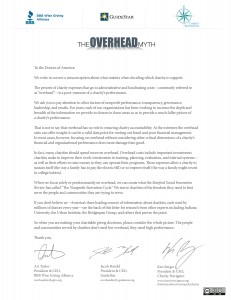 For the last few years, I’ve come across snippets and whispers from non-profit thought-leaders about how we need to help donors change their views about evaluating a non-profit organization based on how little it spends on administrative and fundraising costs. It was mentioned in polite conversations. A few bloggers were chattering about. I even saw it on a website owned by a charity watchdog group.
For the last few years, I’ve come across snippets and whispers from non-profit thought-leaders about how we need to help donors change their views about evaluating a non-profit organization based on how little it spends on administrative and fundraising costs. It was mentioned in polite conversations. A few bloggers were chattering about. I even saw it on a website owned by a charity watchdog group.
Then a few years ago, Dan Pallotta published a book titled “Uncharitable,” and this discussion emerged from the shadows of the non-profit sector. For the last few years, everyone I know has been engaged in this discussion or pieces of it such as:
- Executive compensation
- Marketing & advertising
- Risk aversion
- Return on investment for donors
- Spending on today versus tomorrow
The overhead myth has been building momentum for a few years now. I even jumped on this bandwagon a year ago with the following series of blog posts:
- DonorDreams blog: “Does your non-profit make a difference? Americans don’t think so!“
- DonorDreams blog: “Why is the non-profit sector hamstrung?“
- DonorDreams blog: “Stop thinking. Stop planning. Start doing!“
 AND THEN IT WENT VIRAL . . .
AND THEN IT WENT VIRAL . . .
A few weeks ago I received an email from a dear friend of mine with a link to “Letter to the Donors of America” from the BBB Wise Giving Alliance, Guidestar and Charity Navigator. The letter was simple and straightforward. It asked donors to please stop looking at overhead when making charitable contributions. It was a case for support document. Pure and simple!
After this first email from a friend, I received another and then another. I started to see bloggers tackle the subject, and then non-profit agencies started talking about it on their websites. Before long, it was all over social media and everyone in my circles was talking about “the overhead myth“.
For the record, I’ve always thought that the idea of using overhead to evaluate a non-profit organization’s worthiness was silly for two reasons:
- Through the magic of accounting, every smart executive director keeps at least one eye on what donors consider the “percentage of overhead” and tweaks their allocation formulas to keep that percentage where it needs to be. So, this number really means nothing. It never has and never will.
- When I am purchasing goods and services, I never hold for-profit companies to this standard. When I hired a marketing firm to help me during the start-up phase for The Healthy Non-Profit LLC, I didn’t look at how much money they spent on administration, executive compensation or their advertising budget. Heck no! I looked at the quality of their work. As a donor, I like to invest in organizations whose programs are having impact regardless of how much they pay their executive director.
I’ve been asked by some readers of this blog to write something about the “overhead myth“. As flattering and tempting it is to weigh-in on a compelling subject like this, I’m going to use some self-restraint and decline. (Surprising? I know!)
Why?
Have you see how much has already been written out there? OMG!!! Everyone with a blog, website, Facebook page, and Twitter account has jumped on this bandwagon.
I’m will use the remainder of my space to post links to those other blogs, websites, etc. If you are very interested in this topic, please click your heart away.
- The Overhead Myth website: “It is Time to Move Beyond Overhead“
- Bloomerang: “The Most Important Statement in the Nonprofit World in the Last Decade“
- Nonprofit Association of the Midlands: “Help End the Overhead Myth“
- The Rebecca Gordon Group: “Tackling the Overhead Myth — An Upcoming Blog Series“
- Philantech: “Financial Ratios for Nonprofits — The Overhead Myth“
- Huffington Post: “How a TED Talk Destroyed the Charity Overhead Myth“
- Nonprofit Quarterly: “The Overhead Myth“
- Sasha Dichter’s blog: “The Overhead Myth“
- Sidekick Solutions: “Value Can Unlock the Nonprofit Overhead Myth“
- Childfund International: “End the Overhead Myth”
- Jazi: “End the Overhead Myth“
- And this list is just the tip of the iceberg. If this doesn’t quench your thirst, then go to Google and click-click-click.
Your thoughts?
Let’s start a discussion using the comment box attached to this DonorDreams blog post.
I personally don’t think anything is going to change as a result of this “overhead myth” campaign push.
I think donors are set in their ways. I believe Dan Pallotta was right about the Puritan influence on our culture. I don’t think “culture” and “values” and “habits” are easy to change. AND I think talk is cheap.
In the comment box below, please tell me why you think I am right or why I am wrong.
Here’s to your health!
Erik Anderson
Founder & President, The Healthy Non-Profit LLC
www.thehealthynonprofit.com
erik@thehealthynonprofit.com
http://twitter.com/#!/eanderson847
http://www.facebook.com/eanderson847
http://www.linkedin.com/in/erikanderson847
